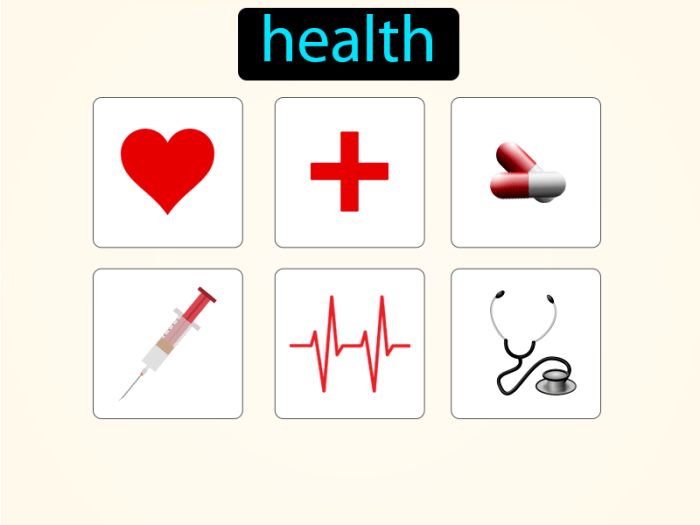Health Spanish delves into the unique challenges and opportunities surrounding healthcare in Spanish-speaking communities worldwide. It explores how cultural factors shape health practices and beliefs, examines the accessibility of healthcare resources, and highlights the crucial role of language and technology in improving health outcomes.
This exploration encompasses a range of topics, including the prevalence of specific health concerns, the impact of socioeconomic factors, and the importance of culturally sensitive healthcare delivery. It also examines innovative approaches to health communication and the potential of technology to bridge healthcare gaps in Spanish-speaking communities.
The Importance of Health in Spanish-Speaking Communities

The health of Spanish-speaking communities is a crucial aspect of global health, encompassing diverse populations across the Americas, Europe, and Africa. Understanding the unique challenges and cultural factors that influence health practices within these communities is essential for developing effective healthcare strategies and promoting well-being.
Health Challenges in Spanish-Speaking Communities
Spanish-speaking communities worldwide face various health challenges, often stemming from socioeconomic disparities, limited access to healthcare, and cultural factors that impact health practices and beliefs.
- High Rates of Chronic Diseases:Non-communicable diseases such as diabetes, heart disease, and cancer are prevalent in many Spanish-speaking communities, often linked to factors like diet, physical activity levels, and access to healthcare.
- Health Disparities:Socioeconomic disparities contribute to health disparities, with marginalized groups experiencing higher rates of chronic diseases, premature mortality, and limited access to quality healthcare.
- Infectious Diseases:Certain infectious diseases, such as tuberculosis, HIV/AIDS, and dengue fever, remain significant health concerns in some Spanish-speaking regions, particularly those with limited access to sanitation, clean water, and healthcare services.
- Mental Health:Mental health issues, including depression, anxiety, and substance abuse, are often underreported and undertreated in Spanish-speaking communities, due to stigma, cultural barriers, and limited access to mental health services.
Cultural Factors Influencing Health Practices
Cultural factors play a significant role in shaping health practices and beliefs in Spanish-speaking countries. These factors can influence health-seeking behavior, treatment preferences, and overall health outcomes.
- Traditional Medicine:Traditional medicine, often referred to as “medicina tradicional,” is widely practiced in many Spanish-speaking communities. These practices include the use of herbal remedies, homeopathy, and spiritual healing, often complementing or substituting conventional medical care.
- Family and Community:Family and community ties are strong in many Spanish-speaking cultures, influencing health practices and support networks. Family members often play a central role in providing care and decision-making regarding health issues.
- Dietary Habits:Traditional diets in Spanish-speaking countries vary significantly but often include staple foods like rice, beans, corn, and various fruits and vegetables. However, dietary changes associated with urbanization and globalization have led to an increase in processed foods and sugary drinks, contributing to health problems.
- Beliefs about Illness:Cultural beliefs about illness and disease can influence health-seeking behavior and treatment preferences. Some beliefs may lead to delays in seeking medical care or reliance on traditional practices rather than conventional medicine.
Traditional Medicine and Health Practices
Traditional medicine and health practices have been integral to Spanish-speaking cultures for centuries. These practices often involve the use of natural remedies, herbal preparations, and spiritual healing techniques.
- Herbal Remedies:Herbal remedies are widely used in Spanish-speaking communities for various ailments. Examples include using chamomile tea for relaxation, ginger for nausea, and aloe vera for skin conditions.
- Homeopathy:Homeopathy, a system of medicine based on the principle of “like cures like,” is practiced in some Spanish-speaking countries. Homeopathic remedies are often used for a range of conditions, including allergies, respiratory problems, and digestive issues.
- Spiritual Healing:Spiritual healing practices, such as prayer and rituals, are common in many Spanish-speaking cultures. These practices are often believed to promote healing and well-being, particularly in cases of chronic or complex illnesses.
Health Resources and Access in Spanish

Access to healthcare services in Spanish-speaking regions varies significantly depending on the specific country and region. While some countries have robust healthcare systems, others face challenges in providing equitable and accessible care, particularly in rural areas.
This section delves into the availability and accessibility of healthcare services in Spanish-speaking regions, exploring examples of organizations and initiatives promoting health awareness and education in Spanish, and discussing the challenges and opportunities in providing culturally sensitive healthcare in Spanish.
Learning Spanish can be a valuable asset, especially when it comes to navigating healthcare situations. If you find yourself in need of urgent medical attention, understanding the language can make a difference. For those in the San Diego area, the UC San Diego Health Emergency Department offers comprehensive care, and having some basic Spanish phrases can help you communicate effectively with staff.
Whether you’re traveling or simply want to better connect with your community, investing in language skills can be beneficial in various aspects of life, including healthcare.
Availability and Accessibility of Healthcare Services
The availability and accessibility of healthcare services in Spanish-speaking regions vary greatly. Some countries, such as Argentina and Cuba, have universal healthcare systems that provide access to basic healthcare services for all citizens. However, in other countries, like Mexico and many countries in Central and South America, access to healthcare can be limited, especially for marginalized populations.
Several factors contribute to disparities in healthcare access, including:
- Geographic Location:Rural areas often lack sufficient healthcare infrastructure and personnel, making it difficult for residents to access care.
- Economic Status:Poverty can limit access to healthcare due to high costs, insurance barriers, and lack of transportation.
- Language Barriers:While Spanish is the primary language in many regions, indigenous languages and dialects may create communication challenges in healthcare settings.
- Cultural Differences:Cultural beliefs and practices can influence healthcare seeking behavior and acceptance of medical interventions.
Organizations and Initiatives Promoting Health Awareness and Education
Numerous organizations and initiatives are working to improve health awareness and education in Spanish-speaking communities. These efforts aim to empower individuals with knowledge and resources to make informed decisions about their health and well-being.
- Pan American Health Organization (PAHO):PAHO, a regional office of the World Health Organization, plays a vital role in promoting health in the Americas, including Spanish-speaking countries. It provides technical assistance, conducts research, and advocates for policies that improve health outcomes.
- The National Hispanic Medical Association (NHMA):The NHMA is a non-profit organization dedicated to improving the health of Hispanic communities in the United States. It provides resources, advocacy, and education to Hispanic healthcare professionals.
- Community Health Centers:Many community health centers in Spanish-speaking regions provide culturally sensitive healthcare services, including language interpretation, outreach programs, and health education materials in Spanish.
Challenges and Opportunities in Providing Culturally Sensitive Healthcare
Providing culturally sensitive healthcare in Spanish-speaking communities presents both challenges and opportunities. It is crucial to address cultural beliefs and practices that may influence healthcare seeking behavior, treatment preferences, and adherence to medical recommendations.
Key challenges include:
- Language Barriers:Effective communication is essential for providing quality healthcare. Language barriers can lead to misunderstandings, misdiagnosis, and poor patient outcomes.
- Cultural Differences:Cultural beliefs and practices can influence perceptions of illness, treatment preferences, and patient-provider interactions.
- Access to Interpreters:The availability of qualified interpreters can be limited, especially in rural areas.
Opportunities for providing culturally sensitive healthcare include:
- Cultural Competency Training:Training healthcare professionals in cultural competency can enhance their understanding of diverse cultural perspectives and improve communication with patients.
- Community Engagement:Engaging with community leaders and organizations can help healthcare providers better understand the needs and priorities of Spanish-speaking communities.
- Development of Culturally Appropriate Materials:Creating health education materials in Spanish that are culturally relevant and sensitive can improve patient understanding and engagement.
Common Health Concerns in Spanish-Speaking Communities: Health Spanish

Spanish-speaking communities worldwide face unique health challenges that often stem from a complex interplay of socioeconomic, environmental, and cultural factors. Understanding these health concerns is crucial for developing effective public health interventions and promoting health equity.
Prevalence of Chronic Diseases
Chronic diseases, such as heart disease, diabetes, and cancer, are disproportionately prevalent in Spanish-speaking populations. This trend can be attributed to a combination of factors, including:
- Socioeconomic Disparities:Limited access to healthcare, lower socioeconomic status, and higher rates of poverty can contribute to poor health outcomes and increased risk of chronic diseases.
- Dietary Factors:Traditional diets in many Spanish-speaking communities often feature high levels of saturated fats, sugar, and salt, which can increase the risk of chronic diseases.
- Lifestyle Choices:Sedentary lifestyles, smoking, and alcohol consumption are also significant risk factors for chronic diseases and are prevalent in some Spanish-speaking communities.
Impact of Environmental Factors
Environmental factors play a crucial role in shaping the health of Spanish-speaking communities. For example:
- Air Pollution:Exposure to air pollution, particularly in urban areas, can lead to respiratory problems, cardiovascular disease, and other health issues.
- Water Quality:Access to safe and clean water is essential for good health, but in some Spanish-speaking communities, water quality issues can contribute to the spread of infectious diseases.
- Climate Change:The impacts of climate change, such as extreme weather events and rising temperatures, can exacerbate existing health problems and create new challenges for vulnerable populations.
Influence of Cultural Practices
Cultural practices can have both positive and negative impacts on health outcomes. For example:
- Family Structure:Strong family ties and support networks can be beneficial for health, but they can also contribute to the spread of certain diseases.
- Traditional Medicine:Many Spanish-speaking communities rely on traditional medicine practices, which can sometimes be beneficial but can also pose risks if not properly integrated with modern healthcare.
- Food Culture:Food plays a central role in many Spanish-speaking cultures, and traditional diets can be both healthy and unhealthy, depending on their specific components.
Health Communication and Information in Spanish
Effective health communication is crucial for improving health outcomes, especially in Spanish-speaking communities. Language and cultural factors play a significant role in how individuals understand and respond to health information.
Importance of Providing Health Information in Spanish
Providing health information in Spanish is essential for improving patient understanding and engagement. When patients receive information in their native language, they are more likely to comprehend it, ask questions, and follow medical advice. This can lead to better adherence to treatment plans, improved self-management of chronic conditions, and increased access to preventive services.
Strategies for Communicating Health Information in Spanish
- Use clear and concise language:Avoid medical jargon and complex terminology that may be difficult for patients to understand. Use simple, everyday language that is easy to comprehend.
- Employ culturally appropriate materials:Consider the cultural context of the audience and use materials that are relevant and relatable to their experiences. For example, using images or stories that reflect their cultural background can make the information more accessible.
- Offer interpreter services:Provide access to qualified interpreters who can accurately translate medical information and facilitate communication between healthcare providers and patients.
- Utilize technology:Leverage technology to reach Spanish-speaking communities with health information. This can include using websites, mobile apps, and social media platforms in Spanish.
- Train healthcare providers:Ensure that healthcare providers have the necessary cultural competency and language skills to effectively communicate with Spanish-speaking patients.
Health Technology and Innovation in Spanish

The use of technology is revolutionizing healthcare delivery in Spanish-speaking communities, offering innovative solutions to address challenges related to access, education, and communication. From telehealth platforms to mobile health applications, these advancements are bridging the gap in healthcare disparities and empowering individuals to take charge of their well-being.
Telehealth and Mobile Health Technologies
Telehealth and mobile health technologies are rapidly transforming healthcare delivery in Spanish-speaking communities, offering a range of benefits, including increased access to care, improved patient engagement, and reduced healthcare costs.Telehealth platforms enable patients to consult with healthcare professionals remotely through video conferencing, phone calls, or online messaging.
This is particularly beneficial for individuals living in rural areas or those with limited mobility. Mobile health apps provide personalized health information, track health data, and facilitate communication with healthcare providers. These technologies are empowering individuals to take a more active role in managing their health and making informed decisions.
For example, the “Salud en Tus Manos”app, developed by the Pan American Health Organization (PAHO), provides Spanish-speaking users with access to reliable health information, symptom checkers, and appointment scheduling tools. This app has proven to be a valuable resource for promoting health awareness and empowering individuals to make informed decisions about their health.
Health Policy and Advocacy in Spanish-Speaking Communities
The health policies and initiatives implemented in Spanish-speaking countries have a significant impact on the well-being of their populations. These policies are often shaped by global health trends, national priorities, and the unique health challenges faced by these communities.
Understanding the nuances of these policies and the advocacy efforts surrounding them is crucial for improving health outcomes in Spanish-speaking communities.
Current Health Policies and Initiatives, Health spanish
Spanish-speaking countries have adopted various health policies and initiatives to address diverse health needs. These policies often focus on strengthening primary healthcare systems, expanding access to essential medications, promoting preventive health measures, and tackling chronic diseases.
- Universal health coverage (UHC) is a prominent policy objective in many Spanish-speaking countries. UHC aims to ensure that all individuals have access to quality healthcare services without facing financial hardship. Countries like Mexico, Argentina, and Chile have implemented UHC programs with varying degrees of success.
Staying healthy is a priority for many, and incorporating Spanish into your daily routine can be a fun way to boost your well-being. From learning about traditional Spanish cuisine at American Beauty Venice to practicing conversational Spanish with a language partner, there are numerous ways to make health and language learning go hand in hand.
As you expand your Spanish vocabulary, you’ll also be expanding your understanding of different cultures and their approach to health and wellness.
- Many countries are actively working to combat non-communicable diseases (NCDs) like heart disease, cancer, diabetes, and respiratory illnesses. These policies often involve promoting healthy lifestyles, strengthening disease surveillance systems, and expanding access to treatment and rehabilitation services.
- Strengthening primary healthcare systems is another key policy focus. Primary healthcare plays a crucial role in promoting preventive care, managing chronic conditions, and providing essential health services. Many countries are investing in training healthcare providers, improving infrastructure, and expanding the reach of primary care services.
Challenges and Opportunities in Advocacy
Advocacy for improved health outcomes in Spanish-speaking communities presents both challenges and opportunities. Understanding the complexities of these challenges and leveraging opportunities is crucial for driving positive change.
Learning Spanish can be a great way to improve your overall health, as it opens up opportunities for communication and cultural immersion. In Texas, accessing healthcare can be a challenge, especially for those seeking affordable options. Fortunately, resources like affordable health coverage texas can help individuals find plans that fit their needs and budget.
By understanding Spanish, you can navigate the healthcare system more effectively and advocate for your health needs, ensuring a healthier and more fulfilling life.
- Access to quality healthcare remains a significant challenge in many Spanish-speaking countries. Limited resources, geographical barriers, and disparities in healthcare access often hinder the ability of individuals to receive timely and effective care. Advocacy efforts are essential to address these inequalities and ensure equitable access to healthcare for all.
- The growing burden of NCDs is another pressing challenge. Advocacy for policies that promote healthy lifestyles, increase access to preventive care, and improve treatment options for NCDs is essential to mitigate the impact of these diseases on communities.
- Strengthening health systems is crucial for improving health outcomes. Advocacy for increased funding, improved infrastructure, and a skilled healthcare workforce is essential to build resilient and effective health systems.
- Engaging with communities is vital for successful advocacy. Community-based organizations, patient groups, and local leaders play a critical role in identifying health needs, advocating for policy changes, and ensuring that policies are implemented effectively.
Key Stakeholders in Health Policy and Advocacy
A diverse range of stakeholders play a crucial role in shaping health policy and promoting health equity in Spanish-speaking communities. These stakeholders include:
- Governments:Governments are responsible for setting health policies, allocating resources, and overseeing the implementation of health programs. They play a crucial role in creating an enabling environment for improved health outcomes.
- International Organizations:Organizations like the World Health Organization (WHO), the Pan American Health Organization (PAHO), and the United Nations Children’s Fund (UNICEF) provide technical assistance, financial support, and policy guidance to Spanish-speaking countries.
- Civil Society Organizations:Non-governmental organizations (NGOs), community-based organizations, and patient groups play a vital role in advocating for policy changes, raising awareness about health issues, and providing support to vulnerable populations.
- Healthcare Providers:Doctors, nurses, and other healthcare professionals are directly involved in delivering care and have a significant impact on the health of communities. Their input is essential in shaping policies that address the needs of patients and promote quality care.
- Researchers and Academics:Researchers and academics play a vital role in generating evidence-based information, conducting health policy analyses, and providing insights to policymakers.
- Private Sector:The private sector plays a role in health policy through its involvement in healthcare delivery, pharmaceutical production, and health insurance. Advocacy efforts are needed to ensure that private sector actors prioritize public health and promote equitable access to healthcare.
Final Thoughts

By understanding the nuances of health within Spanish-speaking communities, we can work towards creating a more equitable and accessible healthcare system that empowers individuals and promotes well-being. This journey requires a commitment to cultural sensitivity, language accessibility, and the ongoing development of innovative solutions to address the unique needs of these diverse populations.
Common Queries
What are some examples of traditional medicine practices common in Spanish-speaking cultures?
Traditional medicine practices in Spanish-speaking cultures can vary depending on the region. Some common examples include herbal remedies, homeopathy, and spiritual healing practices.
How can technology improve healthcare access in Spanish-speaking communities?
Technology can play a significant role in bridging healthcare gaps by providing access to telehealth services, mobile health applications, and online health information in Spanish.
What are some key organizations promoting health awareness and education in Spanish?
Organizations like the Pan American Health Organization (PAHO) and the National Hispanic Medical Association (NHMA) are actively involved in promoting health awareness and education initiatives in Spanish-speaking communities.